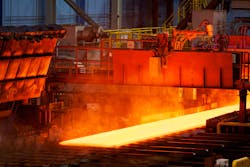Tariffs Are Keeping US Steel Production Strong
Americans may not be aware of it, but the United States has been experiencing a steel boom of late. Last month, U.S. Steel Corporation produced the first ton of steel at a brand-new facility in Fairfield, Alabama. Their new plant uses the latest and cleanest steelmaking technology available—an electric arc furnace (EAF)—and will produce 1.6 million tons of steel a year.
At the same time, Nucor Steel has started building a new steel plate mill in Brandenburg, Kentucky, that will employ 400 workers at an average annual salary of $72,800. And earlier this summer, Commercial Metals Company announced plans to build a second rebar steel mill in Mesa, Arizona, that will employ 185 workers.
All of this is happening even as some pundits and economists say America’s steel industry is in decline. But for those who understand the steel industry, it’s clear that the Trump administration’s steel tariffs have generated a boom in steel investment and a shift to newer technologies that are creating high-paying jobs for thousands of new steelworkers.
In 2018, the Trump administration enacted steel tariffs under Section 232 of U.S. trade law. At the time, the administration cited national security concerns—that a healthy, technologically advanced industry needs high-quality steel to maintain competitiveness, including in areas like advanced military equipment, armaments, and infrastructure.
The major concern, of course, was China. The Chinese steel industry dominates global industry, and accounted for 53% of worldwide production in 2019. Much of this has been driven by massive government subsidization. The end result is millions of tons of steel being dumped in foreign markets. That has depressed global steel prices and made it extremely difficult for U.S. producers to compete.
The steel tariffs have succeeded by reducing the level of these imports in the U.S. This has allowed domestic steel producers to make needed investments while taking the industry forward with confidence.
The Department of Commerce’s August steel report demonstrates that the tariffs were successful in driving down import market share. AISI steel trade association data shows that steel imports in the first nine months of 2020 accounted for just 18% of the U.S. market, down from the 25 to 35% range before the tariffs. It’s now even lower than the 21% target originally set by the Commerce Department in 2018.
With steel imports down, America’s steelmakers have started investing at home. In addition to Nucor and US Steel, companies like Cleveland-Cliffs, Steel Dynamics, CMC, and AK Steel have invested billions of dollars in at least 16 major new projects throughout the nation. The top five US steel companies more than doubled their total annual investments between 2017 to 2019, from $1.5 billion to $4.2 billion. These new steelmaking plants, steel mills, and ore processing facilities use modern technology like electric arc furnace steelmaking (EAF) that is cleaner and more efficient per ton of crude steel produced.
The U.S. now has a more modern steel industry than it has had for decades—and is producing 70% of its steel via EAF, one of the highest figures among major steel-producing nations. In contrast, China produces just 10% of its steel via EAF. China is not only the major source of world oversupply of steel but also the major supplier of dirty blast-furnace-based steel production. The carbon border tax that Joe Biden is reported to favor could be used in conjunction with the Section 232 tariffs to keep out low-quality steel from China and other older-technology steelmaking nations.
These upgrades have benefited U.S. workers. According to SEC data, the average median pay for employees at the top five steelmakers is nearly $83,000. Two of the top five steelmakers paid a six-figure income to its median employees in 2019. In contrast, the median pay at five of the largest U.S. employers, including Walmart, is just under $27,000. Essentially, steelworkers earn triple the median pay of the most common U.S. employers in rural America. Companies like Nucor and Steel Dynamics, which pay profit-linked bonuses to employees, are role models for modern manufacturing excellence.
Some critics claim the tariffs have increased steel prices and hurt steel consumers. The price of steel can indeed be volatile. It surged for six months when the tariffs were first imposed, but then began to fall rapidly. In 2019, the average price of steel was actually lower than the level of 2017, based on SteelBenchmarker industry data. Despite the tariffs, steel prices today remain below their 2017 level. This is because domestic competition remains strong and vigorous.
The 2018 tariffs have made the steel market more stable and reliable. Steel consumers, including auto companies and many others, welcome the greater security of supply, the new grades of steel available from the new mills, and the healthy competitive environment.
The incoming Biden administration will face a choice of whether to continue the current steel policy. However, the idea that—rather than tariffs—a multinational conference can change China’s subsidized overproduction is wishful thinking. The U.S. government owes it to the nation’s workers, manufacturers, and national security sector to maintain a strong and growing steel industry.
Jeff Ferry is chief economist at the Coalition for a Prosperous America. Follow him on Twitter at @menloferry.
